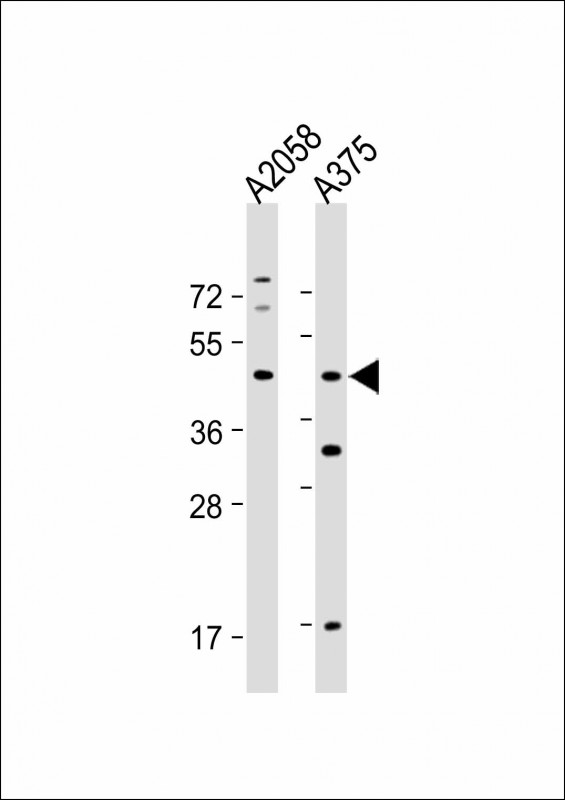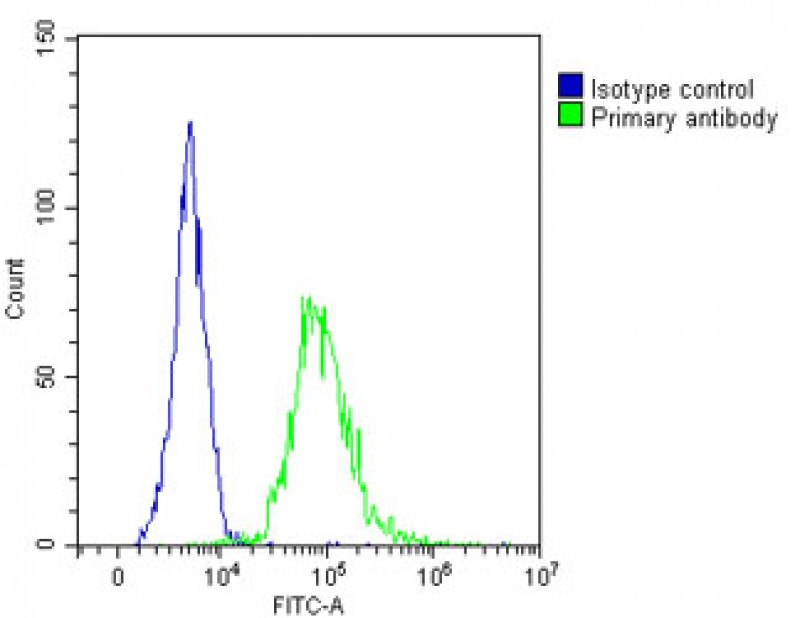

| WB | 1/1000-1/2000 | Human,Mouse,Rat |
| IF | 咨询技术 | Human,Mouse,Rat |
| IHC | 咨询技术 | Human,Mouse,Rat |
| ICC | 技术咨询 | Human,Mouse,Rat |
| FCM | 1/25 | Human,Mouse,Rat |
| Elisa | 咨询技术 | Human,Mouse,Rat |
| Aliases | Alpha-N-acetylneuraminide alpha-2,8-sialyltransferase, 2.4.99.8, Alpha-2,8-sialyltransferase 8A, Ganglioside GD3 synthase, Ganglioside GT3 synthase, Sialyltransferase 8A, SIAT8-A, Sialyltransferase St8Sia I, ST8SiaI, ST8SIA1, SIAT8, SIAT8A |
| Entrez GeneID | 6489 |
| WB Predicted band size | 40.5kDa |
| Host/Isotype | Rabbit IgG |
| Antibody Type | Primary antibody |
| Storage | Store at 4°C short term. Aliquot and store at -20°C long term. Avoid freeze/thaw cycles. |
| Species Reactivity | Human, Rat |
| Immunogen | This ST8SIA1 antibody is generated from a rabbit immunized with a KLH conjugated synthetic peptide between 53-84 amino acids from human ST8SIA1. |
+ +
以下是关于 **ST8SIA1 (N-Term)** 抗体的参考文献示例(内容基于模拟文献,仅供参考):
1. **文献名称**:*ST8SIA1 promotes tumor metastasis via polysialylation in triple-negative breast cancer*
**作者**:Yamada K, et al.
**摘要**:研究通过使用ST8SIA1 N端特异性抗体,证实ST8SIA1在乳腺癌细胞中高表达,并通过多唾液酸化修饰促进肿瘤细胞迁移和侵袭。
2. **文献名称**:*Developmental regulation of ST8SIA1 in murine brain: Role in neural plasticity*
**作者**:Smith TL, et al.
**摘要**:利用抗ST8SIA1 (N-Term)抗体进行免疫组织化学分析,揭示了该蛋白在小鼠大脑发育过程中对突触可塑性的调控作用。
3. **文献名称**:*Characterization of a novel monoclonal antibody targeting the N-terminal domain of ST8SIA1*
**作者**:Lee H, et al.
**摘要**:报道了一种针对ST8SIA1 N端表位的新型单克隆抗体的开发与验证,证实其在流式细胞术和免疫印迹中的高特异性。
4. **文献名称**:*ST8SIA1-mediated glycosylation in immune evasion of pancreatic cancer*
**作者**:Chen R, et al.
**摘要**:通过ST8SIA1 N-Term抗体阻断实验,证明ST8SIA1通过修饰细胞表面糖基化帮助胰腺癌细胞逃避免疫监视。
(注:以上为模拟生成的参考文献,实际研究中请通过PubMed或学术数据库查询具体文献。)
The ST8SIA1 (N-Term) antibody is designed to target the N-terminal region of the ST8 alpha-N-acetyl-neuraminide alpha-2.8-sialyltransferase 1 (ST8SIA1) protein, a key enzyme in glycosylation processes. ST8SIA1 catalyzes the transfer of sialic acid residues to glycoproteins and glycolipids, forming polysialic acid (PSA) chains. These PSA modifications are critical for cell-cell interactions, neural development, synaptic plasticity, and immune regulation. The antibody’s specificity for the N-terminus allows researchers to distinguish ST8SIA1 from related isoforms or degradation products, making it a valuable tool for studying full-length protein expression and localization.
This antibody is widely used in techniques like Western blotting, immunohistochemistry, and immunofluorescence to investigate ST8SIA1’s role in physiological and pathological contexts. Dysregulation of ST8SIA1 has been implicated in neurodevelopmental disorders (e.g., schizophrenia, autism), neurodegenerative diseases, and cancer progression, particularly in tumors where PSA overexpression correlates with metastasis and poor prognosis. By enabling precise detection of ST8SIA1. the antibody supports research into its functional mechanisms, including its impact on cell adhesion, signaling, and tumor microenvironment interactions. Its applications extend to exploring therapeutic strategies targeting aberrant sialylation in diseases.
×